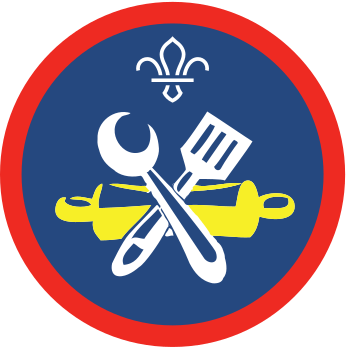Calamitous campsites
You’ll need
- Pens or pencils
- Notepads or paper
- Camping gear
- Clipboards, as needed
Before you begin
- This activity involves setting up a campsite wrongly on purpose, to demonstrate some campsite no-nos. It’s therefore a good idea to do this activity on a weekend camp when you’re all settled in, as you’ll have all the gear you need to hand and plenty of space.
- Hopefully, everyone should have some idea of what a well set-up campsite should look like!
- Anyone working towards their Scouts Camper Activity Badge will need to address and discuss the following requirements in some detail throughout this activity. We’ve included a few prompts as reminders.
- Show that you understand and act on the reasons for hygiene and the importance of being safe and tidy in camp.
- Show how you store food hygienically at camp.
- Learn how to dispose of your rubbish safely and responsibly.
Run the activity
- Everyone should split into groups. Give each group an area of the campsite to ‘set up.’ This might be the sleeping area, the washing up area, a social campfire area or whatever else you’ve got the gear to set up.
- Each group should set up their designated area to demonstrate how that part of the site shouldn’t be set up. This could be done in subtle or obvious ways, though they should take care not to set up something that’s obviously dangerous. Each group should try to have the same number of no-nos, which can be anywhere between 10 and 20, and should make a note of each so that they can fix them all later.
- Once the parts of the site have all been prepared, the person leading the activity should go around and advise each group (and each helper/leader) to be careful as they move about the site from that point onward. Remind them that things could be out of place, to move about slowly and to keep their eyes open.
- Each group should move around the campsite and try to spot the deliberate mistakes made setting up each part of the site. They should write these down as they go.
- Once everyone has explored each area of the campsite, gather together again. Groups should compare notes to see if they found all of the campsite setup mistakes.
- Everyone can now discuss how each campsite setup mistake can be fixed or how such a situation might be avoided. They should talk about what an ideal campsite might look like, bearing in mind that camping affects the world around them, not just the campers.
- Groups can now reform and return to the areas they set up. They should correct all of the deliberate mistakes that they left before and work to transform them into an ideal, fit-for-purpose area of the campsite, using what was discussed to help.
- Poor waste disposal; for example, food bins in sleeping tents or left on the floor within reach of animals.
- A mismanaged woodpile; for example, one that hasn’t been cordoned off properly or one that has materials that you shouldn’t burn on it, such as plastics.
- Unsafe structures, such as unpegged tents or poorly made camp gadgets.
- Poorly chosen locations, such as beneath low-hanging trees or too close to a riverbank.
- Badly stored food containers, such as a cool box sitting in direct sunlight. Be careful not to actually taint or damage any food as you demonstrate this!
- Gas stoves in enclosed, unventilated areas where the gas cannot escape. This is a very serious mistake that can be deadly, so be sure to read the Guidance on safe use of gas appliances. Demonstrations should under no circumstances involve turning on any appliances.
- Campfires set up too close to structures. These shouldn’t be lit for demonstrations.
- Washing stations without suitable soaps, sanitisers or utensils.
- Food preparation areas that aren’t clean or stable.
- Potentially dangerous obstacles that aren’t easily visible at night.
- Errant backpacks or other personal items that are obstacles and trip hazards.
- A lack of separate bags for waste, recycling and food disposal.
Reflection
As they go along, each group should be encouraged to consider how taking ownership and responsibility of a small part of the campsite can help us manage how we spend our time on nights away. Chat as a group about how else you might spread out responsibilities and duties between everyone and what the benefits are of doing so. How might camping with a group allow you to do more activities and go on more adventures safely than you could if camping alone? At the same time, why is it so important that each individual in a group does their bit to make sure that the camp functions as it should?
Safety
All activities must be safely managed. You must complete a thorough risk assessment and take appropriate steps to reduce risk. Use the safety checklist to help you plan and risk assess your activity. Always get approval for the activity, and have suitable supervision and an InTouch process.
- Outdoor activities
You must have permission to use the location. Always check the weather forecast, and inform parents and carers of any change in venue.
- Poles and long objects
Be careful when moving poles or long items. Take care if the ends are sharp. Have appropriate supervision for this activity.
- Heavy and awkward objects
Never lift or move heavy or awkward items alone. Ask for help or, if possible, break them down into smaller parts.
- Sharp objects
Teach young people how to use sharp objects safely. Supervise them appropriately throughout. Store all sharp objects securely, out of the reach of young people.
- Rubbish and recycling
All items should be clean and suitable for this activity.
- Fires and stoves
Make sure anyone using fires and stoves is doing so safely. Check that the equipment and area are suitable and have plenty of ventilation. Follow the gas safety guidance. Have a safe way to extinguish the fire in an emergency.
- Water games and activities
Be careful when doing activities with, in, or near water. Check surfaces and reduce the risk of slipping where possible. Make sure you have appropriate supervision for this activity.
Adjust the number of mistakes each team has to demonstrate to adapt the difficulty, or change the amount of time each group has to find the mistakes.
- If anyone is new to camping and isn’t sure what a bad campsite might look like, then leaders, helpers and peers should help them out. No one should assume that anyone knows everything there is to know about safe, hygienic campsites, and should try to avoid or explain any camping jargon where possible.
- When placing obstacles like dropped backpacks or waste bags, be sure that there is a clear route to pass by them that’s suitable for all of the campers.
All Scout activities should be inclusive and accessible.
When the leaders are done setting up their area, why not reverse roles and have groups go around and inspect what leaders and helpers have put together? Is their camp set up flawed? How could they be more safe, hygienic and responsible as campers?
If everyone needs to spend a little more time focusing on how to set up camp, then why not run Camp kitchen pitchin’? This is an activity where you pitch your ideas for gadgets that promote health and safety.
Young people are shaping their nights away experience by taking part in the activity at the start of their camp. By setting up responsibly, they’re able to enjoy camping more independently and comfortably.


